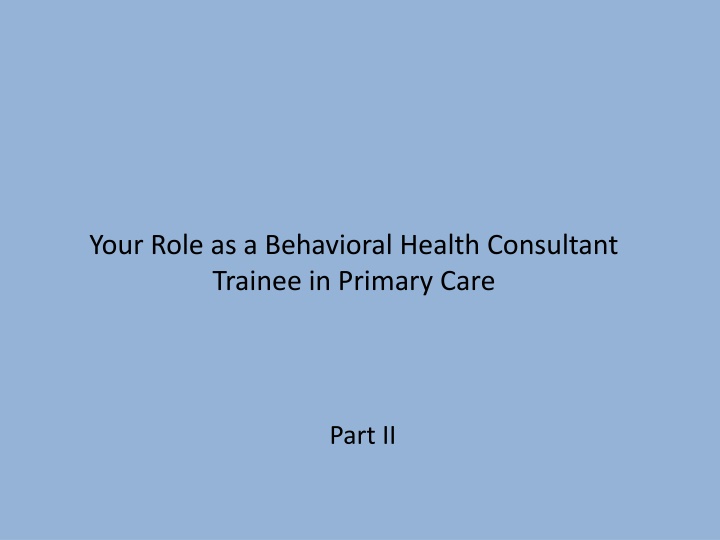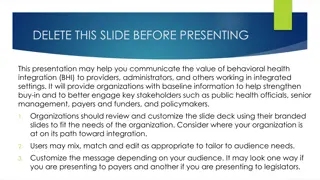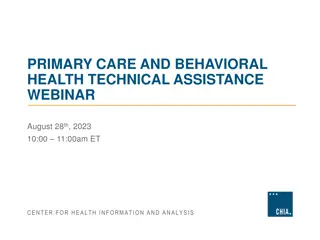Overview of Behavioral Health Consultant Role in Primary Care
Learn about the role of a behavioral health consultant in primary care settings, including conducting brief behavioral interventions, screening for common psychological disorders, and utilizing tools for assessment and intervention. Understand the importance of screening for conditions such as depression, anxiety, substance use, trauma, and cognitive disorders in primary care to improve patient outcomes and intervention efficacy.
Download Presentation

Please find below an Image/Link to download the presentation.
The content on the website is provided AS IS for your information and personal use only. It may not be sold, licensed, or shared on other websites without obtaining consent from the author.If you encounter any issues during the download, it is possible that the publisher has removed the file from their server.
You are allowed to download the files provided on this website for personal or commercial use, subject to the condition that they are used lawfully. All files are the property of their respective owners.
The content on the website is provided AS IS for your information and personal use only. It may not be sold, licensed, or shared on other websites without obtaining consent from the author.
E N D
Presentation Transcript
Your Role as a Behavioral Health Consultant Trainee in Primary Care Part II
Objectives At the end of this workshop, participants will be able to: Describe your role as a behavioral health consultant Identify at least one (1) brief, behavioral intervention for primary care settings. Perform at least one (1) brief, behavioral intervention for primary care settings.
Overview Brief overview of the PCBH model Common Psychological/Behavioral Disorders in Primary Care The Toolkit Behavioral Interventions Self-Assessment/Competency Level
Screening in PC Are you currently screening? If so, what tools are you using? Who is involved in the screening process?
Why Screen in Primary Care? Brief measures can be use to detect behavioral problems ETOH/Substance use Depression/Anxiety Developmental screening Quality of Life Planning and evaluating interventions Screening Diagnosis Robinson & Reiter, 2016
Why Screen in Primary Care? Sensitivity: Identifies most individuals with the condition Specificity: Able to identify individuals without the condition Use the screens as they were designed CBHI, 2010
Screening in PC Depression/Anxiety ETOH/Substance Trauma DV Peds Adolescents Cognitive ADHD Sleep Eating Disorders QoL
Screening: Depression and Anxiety Routine screening for depression improved detection by 10-47%; patient outcomes improved when effective intervention follows screening http://www.phqscreeners.com/ PHQ-9 PHQ-2 Geriatric Depression Scale (15-items) GAD-7 (Anxiety): Best evidence for utility in a primary care setting HADS Anxiety Scale: Older Adults Dennis et al., 2007; Robinson & Reiter, 2016; Hallgren & Morton, 2007;
Screening: Postpartum Period prevalence of depression over the first 3 months postpartum is approximately 19% for major and minor depression and 7% for major depression alone Edinburgh Postnatal Depression Scale (EPDS) 10-items Screen at 3 months post-partum (latest) Can be used up to 12 months post-partum Self-Reporting Questionnaire (SRQ) 20 items World Health Organization Anxiety and Depression http://apps.who.int/iris/handle/10665/61113 O Hara et al., 2012; Pendergast et al., 2014; Santos et al., 2007
Screening: ETOH/Substance Use BI in primary care are efficacious with non-dependent unhealthy users and dependent users seeking help SBIRT? Drug Abuse Screening Test (DAST)-10: Self-report measure for problematic substance use Saitz, 2010; Yudko, Lozhkina & Fouts, 2007
Screening: ETOH/Substance Use Alcohol Use Disorders Identification Test (AUDIT): Self-report measure for hazardous, harmful drinking, as well as ETOH dependence Alcohol, Smoking and Substance Involvement Screening Test (ASSIST): developed to meet the need in primary care areas around the world in which substance use is prevalent to but difficult to detect Developed by the World Health Organization (WHO) in 2002 ASSIST (version 4.0): http://www.who.int/substance_abuse/activities/assist/en/ Humeniak et al., 2008; Saitz, 2010
Screening: Trauma PTSD Checklist (PCL):17-item self-report measure reflecting symptoms of PTSD (DSM-IV) PCL-M vs. PCL-C PCL-5 is a 20-item questionnaire, corresponding to the DSM-5 symptom criteria for PTSD. http://www.ptsd.va.gov/professional/assessment/DSM_5_Validated_ Measures.asp PC-PTSD is a four-item screen for primary care
Screening: Domestic Violence The U.S. Preventive Services Task Force (USPSTF) recommends that clinicians screen women of childbearing age for intimate partner violence (IPV), such as domestic violence, and provide or refer women who screen positive to intervention services. HITS : Hurt, Insulted, Threatened with Harm, and Screamed HITS has been shown to be a valid, consistent scale/screening tool, making it an excellent way for primary care physicians to identify victims of abuse. http://www.getdomesticviolencehelp.com/hits-screening-tool.html Rabin et al., 2009; Taft et al., 2013
Screening: Peds Parents Evaluation of Developmental Status (PEDS): 0-9 years of age Parent-completed questionnaire to facilitate the early identification of developmental and behavioral needs Identifies children with high probability for undiagnosed developmental disabilities requiring further evaluation. Modified Checklist for Autism in Toddlers (M-CHAT) Parent-completed questionnaire used to facilitate the early diagnosis of autistic spectrum disorders (ASD). Validated for children 16 months to 48 months of age CBHI, 2010; Weitzman & Lenventhal, 2006
Screening: Peds Ages and Stages Questionnaires (ASQ-3): Brief (15 min) measure, in which parents rate their child s current skills and development. 1 month to 5.5 years of age Also the Ages and Questionnaires Social-Emotional : identifying children who need mental health support http://agesandstages.com/ ASQ vs. PEDS Both have reasonable test characteristics for developmental screening in primary care settings BUT; ASQ has higher sensitivity and specificity choice of which measure to use should be determined by the practice setting and population served CBHI, 2010; Limbos & Joyce, 2011; Weitzman & Lenventhal, 2006
Screening: Adolescents Pediatric Symptom Checklist (PSC): behavioral health screening tool for children ages 4 to 16 years Youth Pediatric Symptom Checklist (Y-PSC) was developed for youth over age 11 to 18+. PHQ-9: Appropriate for ages 13-17 years PHQ-A: 11-17 years CRAFFT screening for substance-related problems and disorders Under the age of 21 years CBHI, 2010; Johnson et al, 2002; Knight et al., 2002; Richardson et al., 2010; Weitzman & Leventhal, 2010
CRAFFT Part A CRAFFT Part A
Screening: Cognitive Montreal Cognitive Assessment (MOCA): Cut-off score of 26 Sensitive to MCI and broad-based for dementia detection (screening purposes) MMSE most commonly used but insensitive to frontal-executive and sub- cortical functioning as well as milder forms of impairment Mini-Cog: The Mini-Cog is a 3-minute instrument that can increase detection of cognitive impairment in older adults. It consists of two components, a 3-item recall test for memory and a simply scored clock drawing test. As a screening test, however, it does not substitute for a complete diagnostic workup. SLUMS: The Saint Louis University Mental Status (SLUMS) examination is a 30-point screening questionnaire that tests for orientation, memory, attention, and executive functions. Better at mild neurocognitive disorder detection in older adults Damian et al., 2011
Screening: ADULT ADHD Primary care more likely to refer ADHD compared to depression or anxiety Adult ADHD Self-Report (ASRS) v1.1 Screener self-administered six symptoms of ADHD psychometrically determined to be most predictive of diagnosis The Wender Utah Rating Scale: Retrospective 61 items Adler et al., 2009; McCann et al., 2000
Screening: QoL/Function Outcomes-based measures Acknowledge the importance of subjective perceptions of health: function and quality of life Measures change Quality of Life and Enjoyment Scale Short Form SF-36 SF-12 SF-8 Duke Health Profile 17 items CDC HRQoL-14 http://www.cdc.gov/hrqol/hrqol14_measure.htm Brazier et al., 1992; Parkerson et al., 1990
Sleep Insomnia Severity Index The ISI is a 7-item self-report questionnaire assessing the nature, severity, and impact of insomnia. severity of sleep onset, sleep maintenance, and early morning awakening problems, sleep dissatisfaction, interference of sleep difficulties with daytime functioning, noticeability of sleep problems by others, and distress caused by the sleep difficulties. The total score is interpreted as follows: absence of insomnia (0 7); sub-threshold insomnia (8 14); moderate insomnia (15 21); and severe insomnia (22 28). Three versions are available patient, clinician, and significant others but the present paper focuses on the patient version only.
Eating Disorders Screening tools for detection of eating disorders (AN or BN) in primary care: SCOFF ESP
Summary Remember . Sensitivity: Identifies most individuals with the condition Specificity: Able to identify individuals without the condition Use the screens as they were designed Screening Diagnosis
Myths and Misconceptions about behavior change
What happens in therapy? You tell us! Long-term psychotherapy? Brief therapy?
Patients want lots of therapy Patients tend to enter therapy because of heightened levels of distress. As the distress dissipates, they are less inclined to return for additional visits Emotional reassurance Practical problem solving Typically addressed within the first few visits 30-40% of patients stop therapy without consulting the provider Majority end treatment by the 5th visit Modal number of visits? One! What predicts a patient staying in therapy? Psychological distress in other words, they aren t staying in therapy because it s working, they are staying because it isn t working... Strosahl, Robinson, & Gustavsson, 2012
Degree of change is dependent on amount of time in therapy Research published about 25 years ago... the dose-effect relationship 15 % of patients experience clinical improvements before the initial session Thoughts on this? It appears that deciding to get help is helpful in its own right. More recent study (Baldwin et al., 2009): Patients who underwent brief treatment experiences relatively rapid rates of change compared with patients who received longer term treatment The number of sessions was not a significant predictor of clinical change. Therapeutic alliance can be rapidly established in PCBH model and is not required for therapeutic change (Corso et al., 2012) Strosahl, Robinson, & Gustavsson, 2012
The longer the therapy, the more powerful the effects Example: Molenaar et al., 2011: the degree of symptom reduction and long-term improvement in social functioning was just as great in an 8-session treatment compared to 16-session treatment. Recent research suggests that brief treatments are just as effective as longer-term treatment for the same disorder (e.g., depression, PTSD, panic disorder, etc.) Strosahl, Robinson, & Gustavsson, 2012
Brief therapy is a superficial intervention with few long-term benefits One theory of change in psychotherapy is called the phase model The clinical response occurs in three phases and are time dependent: Remoralization: sense of subjective improvement as the patient starts to do something about the problem Remediation: clinical symptoms are reduced to low levels Rehabilitation: stable improvements in functioning begin to appear Bryan, Morrow, Appolonio, & Kanzler (2009): results suggested clinically and statistically significant changes occurred in all three phases of change (2-4 session treatment in a primary care setting) Also, we don t understand therapeutic change quite well (yet) May or may not be influenced by subtle (or not so subtle) communications/expectations from the provider Strosahl, Robinson, & Gustavsson, 2012
Rapid, large clinical gains are rare in therapy Research says otherwise 40-45% of patients with depression exhibit sudden large gains within the first 2-4 treatment sessions PTSD Binge Eating Irritable Bowl Syndrome Associated with long-term improvements in functioning as well as a reduction in relapse rates Strosahl, Robinson, & Gustavsson, 2012
Case Example How might you approach the following cases differently in primary care versus specialty mental health care? Why?
Jane Doe 44 yo, female Latino decent Married for 16 years; does not work (husband works; only one vehicle in home so transportation difficulty at times); No children Minimal family/social support (spends most of her time at home) Health conditions/hx: Type II Diabetes (last A1C in April 2016: 6.9%), Hypertension, Hyperlipidemia, GERD, peripheral neuropathy, Depression, hx of DV (16 years ago) Presents to PCP appt for increased blood sugar You (BHC) have consulted with pt s husband within the past 12 months
Jane Doe Medications: Aspirin 81 mg (heart disease) atorvastatin 40mg (cholesterol) Iron 325mg (anemia) gabapentin 300mg (neuropathy) lisinopril 5mg (hypertension) metformin 500mg 2x/day (diabetes) metoprolol 50mg (heart disease) Ranitidine 150mg (GERD)
Jane Doe Behavioral Health hx: Two past suicide attempts (OD pills) both occurred ~20 years ago during DV No formal behavioral health tx until Feb. 2016 ( a few visits with the behavioral health provider connected to the chronic care program for diabetes) No hx of substance abuse Only uses avoidance-based coping skills at this time
Jane Doe PHQ-9: 12 (scored a 2 on question 9: Thoughts you would be better off dead, or of hurting yourself in some way? ) GAD-7: 10
Jane Doe Referral Question for Same Day Visit ( warm hand-off ): Assistance with depression and mgmt of chronic health conditions What would you do? What intervention would you provide? Anything else you would want to know? Remember, 15-25 minute consult
The Script Handout
Initial Visit BHC Introduction Functional Analysis Problem Specification Conceptualization Teaching New Behavior Life Context Questions Outcome Measures Figure 9.2. Components of a BHC initial visit.























